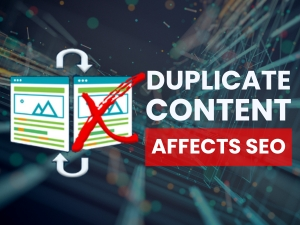Physical Address
304 North Cardinal St.
Dorchester Center, MA 02124
In the ever-evolving landscape of search engine optimization (SEO), duplicate content has become a significant issue for website owners and marketers alike. While it may seem harmless at first glance, duplicate content can lead to a range of problems that adversely impact a website’s visibility and ranking on search engine results pages (SERPs).

This article will delve into the effects of duplicate content on SEO, explore how to resolve duplicate content, and provide actionable tips for preventing duplicate content in SEO.
Duplicate content refers to substantial blocks of text that appear on multiple web pages either within a single domain or across different domains. Search engines like Google strive to deliver the most relevant and diverse content to users. When they encounter duplicate content, they may struggle to determine which version to prioritize, potentially leading to issues for the website owners.
There are two primary types of duplicate content:
Duplicate content can have several negative implications for your website’s SEO. Understanding these effects is crucial for maintaining a healthy and high-performing website.
When multiple pages have the same content, the links pointing to those pages can become diluted. Instead of accumulating link equity (the value passed through links), the links may split their value among the duplicate pages, making it harder for any single page to rank well.
Search engines aim to deliver unique content to users. If they encounter duplicate content, they may choose to ignore one or more versions of that content, resulting in lower rankings for the affected pages. This means that your valuable content might not reach its intended audience.
Search engines allocate a crawl budget to each website, determining how many pages they will crawl in a given time. When a website has duplicate content, search engine crawlers may spend time indexing these duplicate pages instead of discovering new, unique content, effectively wasting your crawl budget.
Duplicate content can lead to confusion for users. If they encounter multiple versions of the same content, it may diminish their trust in the website and create a frustrating experience, ultimately leading to higher bounce rates.
While Google does not impose direct penalties for duplicate content, it can result in poor performance in search results. Websites that engage in black-hat SEO practices, such as content scraping, may face penalties or even de-indexing.
If you’ve identified duplicate content on your website, the next step is to resolve the issue effectively. Here are several strategies to consider:
A canonical tag is an HTML element that helps search engines understand the preferred version of a page. By implementing canonical tags, you can specify which version of duplicate content should be prioritized in search results. This is particularly useful for e-commerce sites with similar product descriptions across multiple pages.
Example:
<link rel="canonical" href="https://www.example.com/original-page-url" />If you have duplicate content that is no longer relevant or necessary, consider using 301 redirects to point users and search engines from the duplicate pages to the original content. This method not only preserves link equity but also provides a better user experience.
For internal duplicate content caused by URL parameters, you can use Google Search Console to inform Google how to handle specific parameters. You can also create canonical URLs to indicate the preferred version.
If multiple pages on your site cover similar topics, consider consolidating them into a single, comprehensive resource. This not only reduces duplication but also improves the overall quality of your content, making it more valuable to users.
To prevent external duplicate content issues, monitor your site for unauthorized copying of your content. You can use tools like Copyscape or Siteliner to check for duplicate content across the web. If you find your content being used without permission, consider reaching out to the offending website to request removal or credit.
The best way to deal with duplicate content is to prevent it from occurring in the first place. Here are some effective strategies for preventing duplicate content in your SEO efforts:
Creating a well-thought-out content strategy can help ensure that your content is unique and relevant. This includes conducting thorough keyword research, identifying gaps in the market, and creating original content that addresses those gaps.
A clean and logical URL structure can help prevent duplicate content issues. Avoid using unnecessary parameters or session IDs in URLs. Instead, use descriptive URLs that reflect the content of the page.
Example:
Instead of www.example.com/products?id=123, use www.example.com/products/shoe-name.
Regularly audit your website for any changes that could lead to duplicate content. This includes checking for updates to existing pages, new pages that may replicate previous content, and ensuring that any content syndication practices do not lead to duplication.
If you work with a team of content creators, ensure they understand the importance of creating unique content. Provide guidelines and resources to help them avoid common pitfalls that could lead to duplication.
Many CMS platforms come with built-in features to help manage duplicate content. For instance, WordPress offers options for creating canonical URLs and managing permalinks. Familiarize yourself with the tools available in your CMS to help mitigate duplicate content.
Duplicate content is a common challenge in the world of SEO, but understanding how duplicate content affects SEO and implementing strategies to resolve and prevent it can significantly improve your website’s performance. By using canonical tags, 301 redirects, and consolidating content, you can effectively manage duplicate content issues. Additionally, creating a strong content strategy, monitoring changes, and educating your team can help you prevent duplicate content from arising in the first place.
In today’s competitive digital landscape, ensuring that your content is unique, valuable, and optimized is essential for achieving higher rankings and providing a positive user experience. By taking proactive steps to address duplicate content, you can enhance your SEO efforts and drive more organic traffic to your site.